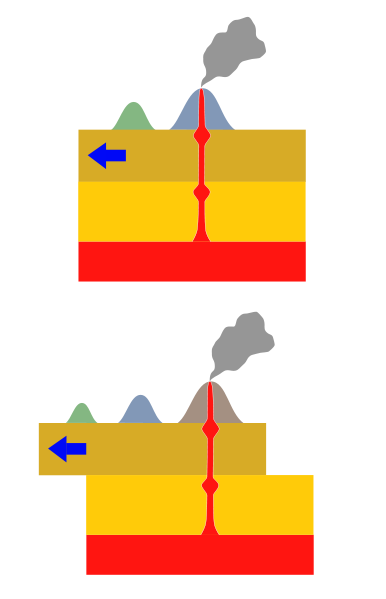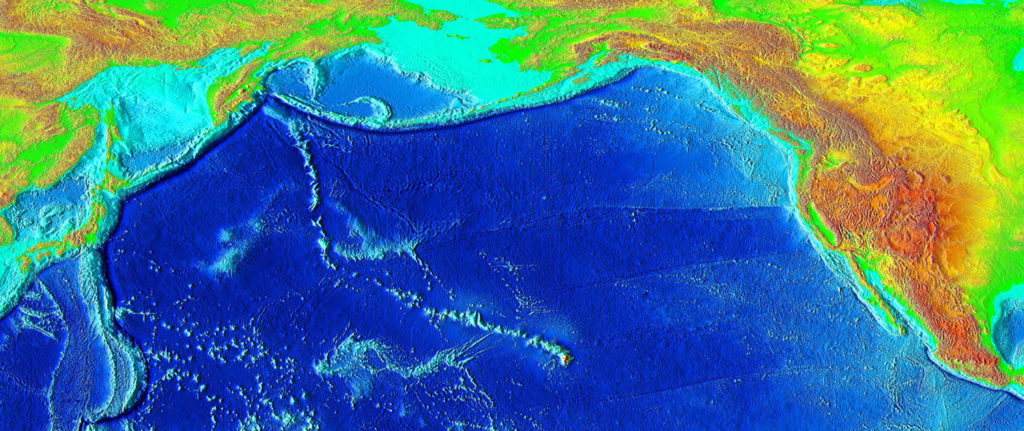52 Volcanoes Hot Spots

Background
The origins of the concept of hotspots lie in the work of J. Tuzo Wilson, who postulated in 1963 that the Hawaiian Islands result from the slow movement of a tectonic plate across a hot region beneath the surface.[10] It was later postulated that hotspots are fed by narrow streams of hot mantle rising from the Earth’s core–mantle boundary in a structure called a mantle plume.[11] Whether or not such mantle plumes exist is currently the subject of a major controversy in Earth science.[12] Estimates for the number of hotspots postulated to be fed by mantle plumes has ranged from about 20 to several thousands, over the years, with most geologists considering a few tens to exist. Hawaii, Réunion, Yellowstone, Galápagos, and Iceland are some of the currently most active volcanic regions to which the hypothesis is applied.

The hotspot hypothesis is now closely linked to the mantle plume hypothesis.
Comparison with island arc volcanoes
Hotspot volcanoes are considered to have a fundamentally different origin from island arc volcanoes. The latter form over subduction zones, at converging plate boundaries. When one oceanic plate meets another, the denser plate is forced downward into a deep ocean trench. This plate, as it is subducted, releases water into the base of the over-riding plate, and this water mixes with the rock, thus changing its composition causing some rock to melt and rise. It is this that fuels a chain of volcanoes, such as the Aleutian Islands, near Alaska.
Hotspot volcanic chains
The joint mantle plume/hotspot hypothesis envisages the feeder structures to be fixed relative to one another, with the continents and seafloor drifting overhead. The hypothesis thus predicts that time-progressive chains of volcanoes are developed on the surface. Examples are Yellowstone, which lies at the end of a chain of extinct calderas, which become progressively older to the west. Another example is the Hawaiian archipelago, where islands become progressively older and more deeply eroded to the northwest.
Geologists have tried to use hotspot volcanic chains to track the movement of the Earth’s tectonic plates. This effort has been vexed by the lack of very long chains, by the fact that many are not time-progressive (e.g. the Galápagos) and by the fact that hotspots do not appear to be fixed relative to one another (e.g. Hawaii and Iceland[14]).

- . “J. Morgan (5 March 1971). \”Convection Plumes in the Lower Mantle.\” Nature 230 (5288): 42-43. doi: 10.1038/230042a0.” ↵
- “Do “plumes exist?\”. Retrieved 2010-04-25. See also, Foulger, G.R. (2010). Plates vs. Plumes: A Geological Controversy. Wiley-Blackwell.” ↵
- Wilson, “J. Tuzo (1963). \”A possible origin of the Hawaiian Islands\” (PDF). Canadian Journal of Physics 41 (6): 863-870. doi:10.1139/p63-094.” ↵
- “Hotspots: “Mantle thermal plumes.\” United States Geological Survey. 1999-05-05. Retrieved 2008-05-15.” ↵
- Foulger, “G.R. (2010). Plates vs. Plumes: A Geological Controversy. Wiley-Blackwell. See also,Wright, Laura (November 2000). \”Earth’s interior: Raising hot spots.\” Geotimes. American Geological Institute. Retrieved 2008-06-15.” ↵
- Holbek, “Peter (November 1983). \”Report on Preliminary Geology and Geochemistry of the Ilga Claim Group\” (PDF). Retrieved 2008-06-15.” ↵
- “What “the hell is Hawaii?\” Retrieved 2011-01-07.” ↵
- . “J. Morgan (5 March 1971). \”Convection Plumes in the Lower Mantle.\” Nature 230 (5288): 42–43. doi: 10.1038/230042a0.” ↵
- “Do “plumes exist?\”. Retrieved 2010-04-25. See also, Foulger, G.R. (2010). Plates vs. Plumes: A Geological Controversy. Wiley-Blackwell.” ↵
- Wilson, “J. Tuzo (1963). \”A possible origin of the Hawaiian Islands\” (PDF). Canadian Journal of Physics 41 (6): 863–870. doi:10.1139/p63-094.” ↵
- “Hotspots: “Mantle thermal plumes.\” United States Geological Survey. 1999-05-05. Retrieved 2008-05-15.” ↵
- Foulger, “G.R. (2010). Plates vs. Plumes: A Geological Controversy. Wiley-Blackwell. See also,Wright, Laura (November 2000). \”Earth’s interior: Raising hot spots.\” Geotimes. American Geological Institute. Retrieved 2008-06-15.” ↵
- Holbek, “Peter (November 1983). \”Report on Preliminary Geology and Geochemistry of the Ilga Claim Group\” (PDF). Retrieved 2008-06-15.” ↵
- “What “the hell is Hawaii?\” Retrieved 2011-01-07.” ↵
